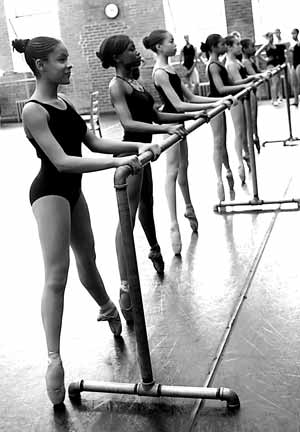
Special Considerations For The Dancer
Injury to the FHL in dancers is often caused by the repetitive motion of changing position from a plié position to a relevé position. This action produces a force that is 10 times the dancer’s body weight.
Ideally, for greater stability and increased propulsion, the foot should be in a supinated position at the heel during push-off. For a dancer, any action that causes a reduction in plantar flexion motion can create an FHL injury. Biomechanically, a lack of plantar flexion leads to a prolonged pronation position of the foot when pushing off in the Propulsion Phase.
In dancers, the FHL tendon is often compressed while performing a relevé position and is over-stretched while performing a plié postion. In such a case, the dancer will feel posterior medial ankle pain when performing the plié. (Photo - Dance Theatre of Harlem).
Diagnosis and Imaging - FHL Injury
X-rays for this condition are not very specific. X-Rays are good for ruling out fractures (Calcaneus, Distal Medial Malleolus, or Os Trigonum) that may cause an impingement of the FHL tendon. It is important to note that X-Rays will not provide a definitive diagnosis of FHL injuries.
A good history is much more definitive, especially when accompanied by a full physical examination and an MRI. MRI imaging is an excellent resource for showing damage to tissue fibers, inflammation, and swelling (edema).
If the MRI is not available or is too expensive, a CT scan (Computed Tomography) can prove to be a useful alternative.
Treatment
In most cases, FHL syndrome (involving partial tears, tendinosis, or inflammatory conditions) responds well to conservative care. However, a complete tear of the FHL tendon may require corrective surgery since serious cases of FHL injury could end an athlete’s career.
Conservative care includes:
· Ice or heat depending on stage and type of injury (inflammation or not). See our Icing and Heating blog.
· Reduction in activity. Usually, some modification in all activities is necessary.
· Supports (crutches or walker boot) can be beneficial.
· Taping – Kinesio Taping. At Kinetic Health we use SpiderTech Kineso-taping.
· Soft-tissue and joint mobilization (Active Release, Graston Techniques, Massage, and Manipulation) are all therapies that we use at Kinetic Health.
· Inflammatory strategy implementation (medication for no longer than seven days). See our blog about Reducing Inflammation.
· Exercises for increased strength, flexibility and balance. Go to www.releaseyourbody.com for exercises you can use to treat this condition.
· Biomechanical corrections (footwear or Kintec Orthotics) such as those recommended or provided at Kinetic Health for patients suffering from these conditions.
· A gradual return to activities.
If you would like more information or to purchase our books please go to www.releaseyourbody.com .
If you would like information about our clinic in Calgary Alberta please go to www.kinetichealth.ca.
(COPYRIGHT KINETIC HEALTH 2012 – ALL RIGHTS RESERVED)
Woooooooooooooooooooooooooooooow /Hey thanks man!! you are so good. I think this the perfect work.
ReplyDeletePlantar Fasciitis Treatment